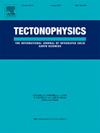中国西北部准噶尔盆地南部空间变化的应力机制
IF 2.7
3区 地球科学
Q2 GEOCHEMISTRY & GEOPHYSICS
引用次数: 0
摘要
中国西北部准噶尔盆地南部是青藏高原地区的一个重要构造单元,其构造过程和地球动力学背景一直是大量研究的重点。然而,该地区深部构造变形与应力之间的关系仍不清楚。本研究利用三维地球物理数据和有限元数值模拟,研究了准噶尔盆地南部的高泉和呼图壁反斜,探讨了深达 7 千米的地壳应力分布和应力机制。数值模拟结果表明,准噶尔盆地南部的应力机制自西向东发生变化。在该地区的西部,包括4900-6100米深处的高泉反斜线,最大水平主应力的峰值为140-200兆帕,最小水平主应力为110-170兆帕,垂直主应力为115-175兆帕,表明该地区的应力体系包含了压缩和走向滑动两种成分。在该地区的东部,包括深度为 5400-7800 米的呼图壁反斜线,最大水平主应力的峰值为 160-280 兆帕,最小水平主应力为 155-250 兆帕,垂直主应力为 125-215 兆帕,表明这是一种压缩应力机制。应力大小和方向受断层的存在和地壳深度的影响。将这些结果与区域构造背景相结合,可以认为原有断层与当前应力场之间的几何关系是应力机制西-东分化的主要控制因素,而地壳力学参数和压力系数的空间变化则是次要因素。这些结果提供了对应力和变形之间关系的见解,并为更新版的世界应力图数据库提供了支持。本文章由计算机程序翻译,如有差异,请以英文原文为准。
Spatially varying stress regime in the southern Junggar Basin, NW China
The southern Junggar Basin in NW China is an important tectonic unit in the region of the Tibetan Plateau and has been the focus of considerable research into its tectonic processes and geodynamic setting. However, the relationship between deep structural deformation and stress in this region remains unclear. This study investigates the Gaoquan and Hutubi anticlines in the southern Junggar Basin using three-dimensional geophysical data and a finite-element numerical simulation to examine the crustal stress distribution and stress regime at depths of up to 7 km. Numerical simulation results indicate that the stress regime in the southern Junggar Basin changes from west to east. In the western part of the region, including the Gaoquan anticline at depths of 4900–6100 m, the maximum horizontal principal stress shows a peak of 140–200 MPa, the minimum horizontal principal stress is 110–170 MPa, and the vertical principal stress is 115–175 MPa, indicating a mixed stress regime incorporating both compression and strike-slip components. In the eastern part of the region, including the Hutubi anticline at depths of 5400–7800 m, the maximum horizontal principal stress shows a peak of 160–280 MPa, the minimum horizontal principal stress is 155–250 MPa, and the vertical principal stress is 125–215 MPa, indicating a compressive stress regime. The stress magnitude and orientation are affected by the presence of faults and depth in the crust. Combining these results with the regional tectonic setting, it is considered that the geometrical relationship between pre-existing faults and the current stress field is the main control on the west–east differentiation in the stress regime, with spatial variations in the mechanical parameters of the crust and the pressure coefficient being secondary factors. These results provide insights into the relationship between stress and deformation, and support the updated version of the World Stress Map database.
求助全文
通过发布文献求助,成功后即可免费获取论文全文。
去求助
来源期刊

Tectonophysics
地学-地球化学与地球物理
CiteScore
4.90
自引率
6.90%
发文量
300
审稿时长
6 months
期刊介绍:
The prime focus of Tectonophysics will be high-impact original research and reviews in the fields of kinematics, structure, composition, and dynamics of the solid arth at all scales. Tectonophysics particularly encourages submission of papers based on the integration of a multitude of geophysical, geological, geochemical, geodynamic, and geotectonic methods
 求助内容:
求助内容: 应助结果提醒方式:
应助结果提醒方式:


